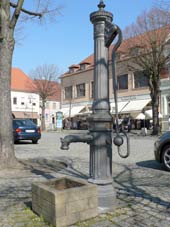Water protected Jüterbog from invaders
At Dammtor (Dam Gate) (3) which is the most important and representative one you can see the role that water played for defence. In the north two water ditches surrounded Jüterbog.
In the south the so called Mühlenteich (mill pond) surrounded the town. Both watercourses meet at Dammtor. There was an outer and an inner wall with an outer and an inner gate. These gates were connected with walls. Thus the security loving Jüterbog people had something like a kennel. In the middle there was a third wall where a third gate house stood. Two bridges overstretched the ditches. During the Thirty Year’s War the defence facilities were seriously damaged.
But when a new excise was introduced (1687) the walls got a new function – tariffs had to be paid on all goods that entered Jüterbog. Prussia abolished this excise in 1819. But it was only in 1840 when Jüterbog’s city fathers decided not to lock up the gates at night any more.
The ditches were filled and the dams were straightened. So today we can only see some parts of the city wall, the towers, and the gates.
Hand pumps instead of wells
In 1841 the first public water pump started to operate in Jüterbog. Two years of argument preceded this event. The older wells were supposed to be substituted by pumps. But many inhabitants could not afford that. The hand pump on the market place (4) symbolizes the achieved progress. Brandenburg’s second-oldest city hall (1507) also stands here.



